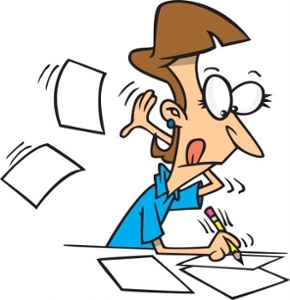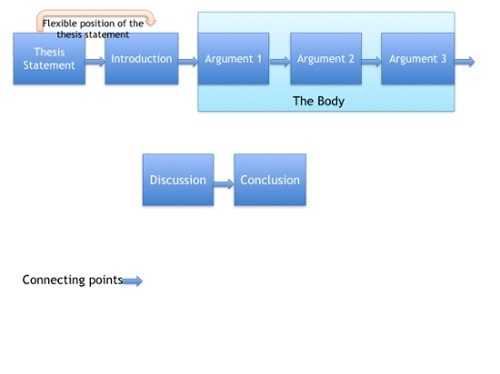Effective Writing Skills

Tips for Effective Writing
Follow the instructions
- Make sure you understand what format you are writing in before you begin. You will take a different approach depending on whether you are writing a term paper, a report, a research proposal or a dissertation.
Audience
- Knowing your audience is essential before beginning the writing process. A different vocabulary and writing structure are necessary if you are writing for an audience outside of your discipline.
Outline
- This is arguably the most important part of the writing process. Having a comprehensive outline is an effective way of creating a clear and organized piece of writing. (Please see the example below.)
Be clear and concise
- This can be one of the most difficult things to achieve. Be ruthless when editing. If it's not relevant it needs to go
- As you are editing, ask yourself “does this help me answer my question or make my argument?”
- Ask a friend or advisor to read it over and take their advice!
Give yourself time
- It's never too early to start a paper and when you leave it to the last minute you risk disaster.
- A coherent argument takes time to develop and you won't have time to edit properly if you write a paper the night before it's due. So get out your planner and think ahead.
Let it go
- After putting a lot of effort into a piece of writing it can be difficult to know when to stop. A piece of writing needs to be effective, not perfect.
- There's no such thing as a perfect essay so if you've made an effective argument, let yourself feel the exhilaration that comes with being done!
Demonstrate your knowledge, not your vocabulary
- We are all guilty of using academic jargon in our writing. Avoid using your thesaurus to come up with a more ‘intelligent’ way of saying something
- Effective writers demonstrate their ability to clearly express ideas through simple language and supporting arguments.
Find your own way
- You might try writing at the same time every day or setting goals such as writing a certain number of words daily. There is no magic formula. Find out which strategies work best for you.
Use the literature effectively
- It's easy to get bogged down in the research phase of a writing project. Starting out with a clear research question that you want to answer can help you focus.
- Once you know the direction you want to take, narrow your research so that you focus only on the literature that will help you defend your thesis.
- Organizing your findings in your outline will help you create a more coherent argument in your paper.
Logical progression
- The best papers allow for a logical progression from one section to the next.
- Examining past thinking and research (historical context) and then progressing to the future through discussions of relevance and impact, will give your work an intuitive logic and help your reader follow your argument.
Some Tricks of the Trade
Avoid ambiguous pronoun use
- A pronoun must refer to a single, particular noun.
- Example: When Samuel dropped the goblet onto the glass table, it broke. (What broke? The table or the goblet?)
- Correction: The goblet broke when Samuel dropped it onto the glass table.
- Tip: you can do a text search for words such as “this”, “that” and “it” while proofreading to help avoid this common error.
Singular or plural
- Make sure that your pronouns agree (singular or plural) with the nouns to which they refer.
- Example: If a student parks a car on campus, they have to buy a parking sticker.
- Correction: If a student parks a car on campus, he or she has to buy a parking sticker.
One paragraph - one idea
- Many writers write long sections of their paper in which they discuss multiple ideas. You can convey your ideas more clearly if you stick to the one paragraph - one idea format.
Figures of speech
- When explaining complicated material don’t be afraid to use devices such as analogy and metaphor to get your point across. These figures of speech can create interest as well as greater understanding of complex ideas.
Do not rely on Spellcheck
- Many of us rely on our own proofreading and editing skills, with a little help from ‘spellcheck’. Grammar, punctuation and spelling errors can be missed using this method
- Try asking a friend to read your work. Someone else can often catch some of the things that both you and your software miss.
Creating a Clear Outline
The 'Storyboard Approach'
A clear outline help you organize your writing. Outlining allows you to determine the flow and logical progression of your paper. The more detailed the outline, the easier it will be to consolidate your ideas into a polished piece of work. The 'storyboard approach' is an effective way to create an outline.

Connecting Points
- The thesis statement is the critical part of the paper that explains not only why you are writing this piece but also why the reader should read it. An effective thesis statement is 1) Clear and concise, 2) Takes a stand on a specific point, 3) Is opposable and defensible (an opposable thesis can be argued against and a defensible thesis will rebut this opposition)
- The body of the paper represents most of its length. The body presents the arguments laid out in the introduction and gives supporting evidence using a variety of references or results. A stronger body portion uses multiple lines of evidence to support your idea.
- The discussion section of the paper synthesizes the arguments presented in the body. It also places those arguments in context, relating them to other ideas and debates, highlighting any new ideas or contributions to knowledge, discussing the implications and applications of your work, or identifying remaining questions.
- The connecting points are essential to the continuity of your paper. These areas (illustrated by arrows in the storyboard) link the different sections of your paper together to help create cohesion and also link each section back to your main argument.
- The conclusion consolidates the main points made in your paper by expanding on the thesis statement. This is also a place to address the next steps or future projects that can be considered based on the research you have conducted. This is not an area to present new information but rather to reinforce the purpose of your paper.
Helpful Links
- Western University Writing Centre - http://www.sdc.uwo.ca/writing/
- American Anthropological Association Citation Style Guide - http://www.aaanet.org/publications/guidelines.cfm
This page was created by Isabella Graham and Ramsay Macfie as part of the 2014 Professional Development class.

